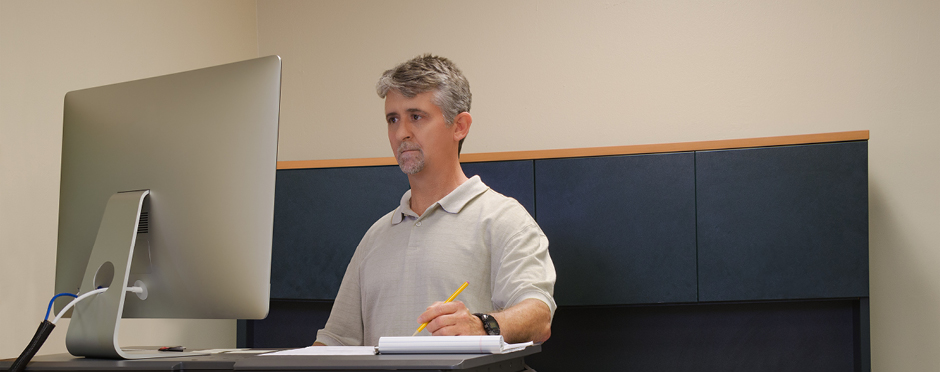
Sitting vs. Standing: The Benefits of Standing
Leave a CommentAs soon as I identify myself as an “ergonomist,” I’m confronted with the same questions regarding ergonomics. No, this question isn’t related to the repetitive nature of assembly line work or the awkward postures assumed by building engineers, but it’s in reference to the continuing debate: Is Standing really better than sitting?
This question is not as simple as it first appears. My “knee-jerk” reaction is always “yes, standing must be better than sitting.” Certainly the benefits of standing (e.g. increased caloric expenditure, increased circulation to distal appendages, etc.) are convincing, however are we gathering the entire story? Are there other factors at play? First, let’s recap the known benefits of standing during office work:
1) The low-back (L4/L5) compressive forces are lower when standing than sitting.
As seen in the diagram, the L4/L5 compressive forces are approximately 40% greater when seated upright versus standing upright. The compressive forces increase even more significantly when assuming the all-too-common “leaning forward posture” during computer work.
However, there is also evidence that suggests that a supportive backrest with an adjustable lumbar support can significantly decrease the compressive forces at the L4/L5 vertebrae.
So, it appears that a low amount of compressive force at the L4/L5 vertebrae can be obtained both in the standing and seated position. Let’s call this a tie.
2) There’s an increased amount of caloric expenditure during standing than sitting.
This benefit is not debatable. Obviously there is more muscular exertion in the lower extremities when standing v sitting. In fact, the University of Minnesota Undergraduate Research Opportunities Program funded a study published in the Journal of Physical Activity and Health that analyzes the caloric expenditure when standing v sitting. The results are quite convincing for advocating for standing v sitting.
Utilizing a population of young adults (~20 years of age ± 1.9 years), the University of Minnesota found that when assuming a standing posture, an additional ~114 kcal are expended each day. This translates to approximately 20,461 kcal, or 5.85 pounds, of additional caloric expenditure over a one-year period.
You might be thinking; wow, 5.85 pounds! How can I afford not to stand during the workday? However, consider standing for 8 hours each day for 5 days / week over 52 weeks / year. That’s quite a bit of standing.
3) Increased circulation – particularly to the lower extremities.
Again, this is a benefit that is generally accepted. Blunt chair edges, increased seat pan tilt, incorrect chair height, etc. are all factors that can contribute to a reduced amount of circulation to the lower extremities. You may be familiar with the feeling of “tightened shoes” later in the workday. This feeling of the shoes tightening is edema in the feet due to a decrease in circulation.
Solutions to this problem may include standing, but you may also choose to utilize an angled footrest to open-up the knee angle or to adjust the chair to increase circulation.
There are certainly other factors at play, and, this debate could (and might) go on forever. Every ergonomist will have their own “opinions” and research to support their beliefs, however I’m authoring this article so I’ll give you my opinion:
Standing is great. The benefits are straightforward and certainly standing will be a better solution to long-duration work than sitting. However, standing is still a static posture. There lacks dynamic movement when standing or sitting which is problematic for a population of “bipeds” who are designed to move throughout the day. So, what is the reality?
Standing positions should be assumed whenever possible while maintaining the freedom to sit whenever fatigue or discomfort occurs. In fact, an article published in the Journal of Ergonomics reports the following:
The lowest percentage of low-back pain amongst the studies population was reported when standing with the possibility of sitting down at will. Only 17.4 percent of the sample population reported discomfort in this setup. Even more convincing is the response by those without the possibility of sitting (e.g. standing all day). 30.4 percent of the sample that stand in a “fixed or relatively fixed position” reported low back pain.
So it turns out that we should absolutely stand, but should switch between sitting and standing – particularly when discomfort occurs. It may be good to switch between sitting and standing on a fixed schedule. 2 hours standing, 1 hour sitting, and repeat. This is a good utilization of a standing workstation and increases your movement to a certain degree.
If you would like to learn more about ergonomics, please use the button below to schedule a complimentary injury screen at an Athletico near you.
Click to Schedule a Complimentary Injury Screen
The Athletico blog is an educational resource written by Athletico employees. Athletico bloggers are licensed professionals who abide by the code of ethics outlined by their respective professional associations. The content published in blog posts represents the opinion of the individual author based on their expertise and experience. The content provided in this blog is for informational purposes only, does not constitute medical advice and should not be relied on for making personal health decisions.
Referenced Work:
Dengel, Donald R., Kara Marlatt, and Christopher Reiff. “Difference in caloric expenditure in sitting versus standing desks.” Journal of Physical Activity and Health 9 (2012): 1009-1011. Print.
Kroemer, K. H. E.. Fitting the task to the human: a textbook of occupational ergonomics.. 6th ed. Boca Raton, Fla.: CRC ;, 2008. Print.
Tissot, F., K. Messing, and S. Stock. “Studying The Relationship Between Low Back Pain And Working Postures Among Those Who Stand And Those Who Sit Most Of The Working Day.” Ergonomics 52.11 (2009): 1402-1418. Print.
